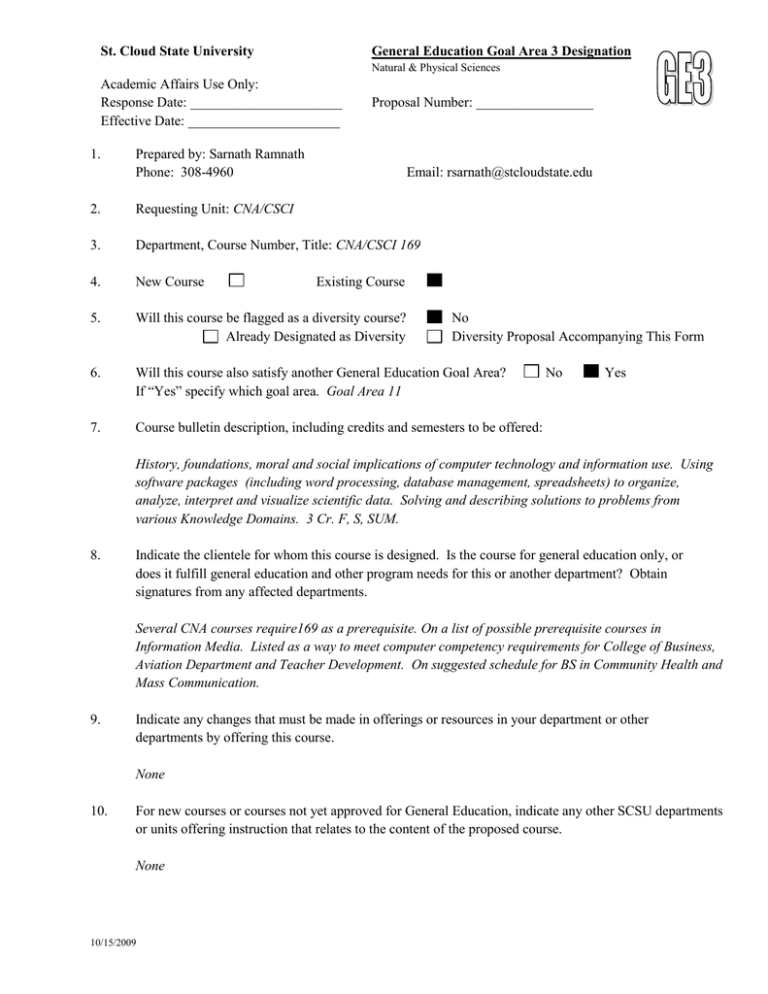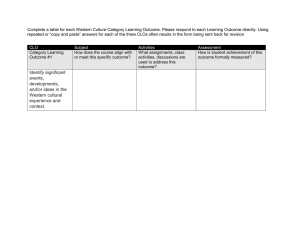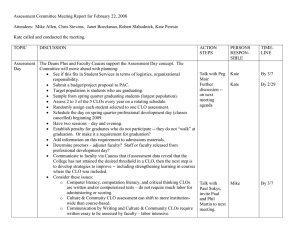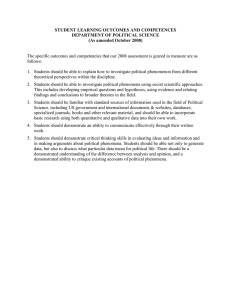St. Cloud State University General Education Goal Area 3 Designation
advertisement

St. Cloud State University General Education Goal Area 3 Designation Natural & Physical Sciences Academic Affairs Use Only: Response Date: ______________________ Effective Date: ______________________ 1. Proposal Number: _________________ Prepared by: Sarnath Ramnath Phone: 308-4960 Email: rsarnath@stcloudstate.edu 2. Requesting Unit: CNA/CSCI 3. Department, Course Number, Title: CNA/CSCI 169 4. New Course 5. Will this course be flagged as a diversity course? Already Designated as Diversity 6. Will this course also satisfy another General Education Goal Area? If “Yes” specify which goal area. Goal Area 11 7. Course bulletin description, including credits and semesters to be offered: Existing Course No Diversity Proposal Accompanying This Form No Yes History, foundations, moral and social implications of computer technology and information use. Using software packages (including word processing, database management, spreadsheets) to organize, analyze, interpret and visualize scientific data. Solving and describing solutions to problems from various Knowledge Domains. 3 Cr. F, S, SUM. 8. Indicate the clientele for whom this course is designed. Is the course for general education only, or does it fulfill general education and other program needs for this or another department? Obtain signatures from any affected departments. Several CNA courses require169 as a prerequisite. On a list of possible prerequisite courses in Information Media. Listed as a way to meet computer competency requirements for College of Business, Aviation Department and Teacher Development. On suggested schedule for BS in Community Health and Mass Communication. 9. Indicate any changes that must be made in offerings or resources in your department or other departments by offering this course. None 10. For new courses or courses not yet approved for General Education, indicate any other SCSU departments or units offering instruction that relates to the content of the proposed course. None 10/15/2009 11. Courses designated as General Education are included in the assessment plan for the Goal Area(s) for which they are approved. Courses for which assessment is not included in the annual GE assessment report for two years will be removed from the General Education Program. The Requesting Unit understands and recognizes the above conditions. 13. Provide a concise explanation of how the following goal is a “significant focus” of the proposed course. Goal Area 3: Natural & Physical Sciences Explore scientific knowledge of the natural world. Understand the central concepts and principles of science; experience the process of scientific inquiry; comprehend science as a human endeavor and understand the impact of science on individuals and on society. a. Explore scientific knowledge of the natural world. (i). Students will see how the basic principles of mechanics, electricity and electronics have been used to create computational tools. (ii). Students will look at data collected from different areas of science and understand how we can advance our knowledge of the world we live in by studying the data. b. Understand the central concepts and principles of science. (i). Students will understand how concepts from physics apply to construction of computing systems. (ii). Students will understand how science is advanced by the collection and analysis of data pertaining to natural phenomena. They will see several examples of these in a historical context and also look at data pertinent to phenomena we are trying to understand today. They will recognize that similar principles of analysis and interpretation have been applied in several contexts. c. Experience the process of scientific inquiry Students will be working with data coming from different knowledge domains and use this data to make and test hypotheses. d. Comprehend science as a human endeavor Students will be studying historical information demonstrating how development occurred in various areas of science through the collection, organization and analysis of data. Students will be interacting with their peers in conducting scientific enquiries. e. Understand the impact of science on individuals and society. Students will study the positive and negative impacts and ethical implications associated with rapid developments in science and technology. 14. In order for a course to be designated as fulfilling Goal Area 3, it must address at least 5 of the 6 student learning outcomes (SLOs) below. Check the SLOs below that are focused on in the proposed general education course. 1. Demonstrate knowledge of concepts, principles, and theories in the physical or natural sciences. 2. Make observations and collect data, design and carry out experiments or other types of scientific investigations. 10/15/2009 3. Formulate research questions and testable hypotheses, analyze and interpret data, draw inferences and conclusions, and identify further questions for investigation. 4. Demonstrate awareness of the interdependent relationships of basic science, applied science, mathematics, and technology. 5. Recognize the human nature of the scientific enterprise, including the importance of curiosity, creativity, and imagination; the dual nature of scientific knowledge as changeable and durable; and the impact of a scientist's personal identity on the scientific process. 6. Evaluate societal issues from a science perspective, question the evidence presented, and make informed judgments about these issues. 15. Discuss how each Student Learning Outcome checked above is achieved in this course. (Note: Although descriptions of typical assignments or types of assignments may be part of this discussion, it is not appropriate to submit copies of actual assignments.) (Note: Following the Course Outline in Item 17 of this document, there is a list of Course Learning Outcomes (CLOs). These CLOs have been referenced in the course of the following discussion.) SLO1: Students understand how principles from Physics and Mathematics come together in the construction of computer systems. They will recognize that Boolean logic forms the basis of computer systems and that Boolean logic can be realized in various physical systems using mechanical, electrical and electronic properties. (CLO 1) SLO2: Students learn how computers can help us organize data through the use of software such as spreadsheets and databases. Students will work with large data sets drawn from Different Knowledge Domains (DKD’s) and use software tools to conduct scientific investigations. There are several data sources relating to natural phenomena, which contain extensive observations. Students will access this information and use the software to carry out investigations. Examples of these include: - Study of bird migration that correlates physical characteristics with migratory behavior. - Estimate the properties of natural systems (e.g. the depth of ice on a lake) using historical behavior. - Investigate trends relating to environmental conditions (carbon emission, average temperatures) by correlating these with other measurable phenomena. SLO3: Students will work with large data sets from DKD’s to formulate and test hypotheses, draw conclusions and identify further questions for investigation. Students will be using correlations from previous assignments (see justification for SLO 2) and use these to make verifiable predictions and identify further questions. (CLO 2, 3, 5) SLO4: Students see the interconnection between Mathematics, Statistics and other areas when using data from DKD’s for scientific investigations. Students will write reports and answer test questions that measure their understanding. (CLO 2, 3, 4 & 5). 10/15/2009 SLO5: CLO’s 8, 9,& 10 provide students with specific anecdotal information that underscores the human nature of scientific enterprise, the changeability and durability of scientific knowledge and the personal impact of scientists on the process. Students will recognize how the development of scientific knowledge in fields of astronomy, census, weather, resolution of estates, tide tables, ballistic calculations, visualization and the genome project both spurred on and were facilitated by the development of computational systems. Students recognize that although the data sets come from different sources and pertain to different domains, similar principles apply when analyzing and interpreting these data sets. Students will also directly experience these aspects of scientific development through CLO’s 6 and 7. SLO6: CLO’s 9 & 11 speak directly to societal issues. CLO’s 2, 3, 4 & 5 involve questioning the evidence and making informed judgments when investigating phenomena from DKD’s. Students will see case studies where conclusions drawn from data were not justified. 16. Courses satisfying Goal Area 3: Natural & Physical Sciences must have either a “traditional lab course or a lab-like experience”. Check which of these apply and supply a brief explanation of how the course is either a laboratory course or incorporates a “lab-like experience”. Course includes: Laboratory Lab-like experience The following quote from a National Research Council subcommittee report may help to identify a course with a laboratory. ”Laboratory experiences provide opportunities for students to interact directly with the material world (or with data drawn from the material world), using the tools, data collection techniques, models, and theories of science.” America's Lab Report: Investigations in High School Science (Free Executive Summary) http://www.nap.edu/catalog/11311.html A lab-like experience is obtained by modeling and investigating phenomena using large data sets. 17. List or attach the Course Outline (adequately described and including percentage of time to be allocated to each topic). Curriculum Committees may request additional information. Topics larger than 20% need to be broken down further. Indicate in your course outline where the Student Learning Outcomes checked above are being met. 10% 15% 5% 15% 5% 15% 15% 15% 5% - 10/15/2009 Binary number systems, mathematical foundations, logic. Basic software and hardware elements of computer systems Sets, relations and database concepts Database applications, using a database to model a system, formulation queries that represent hypotheses. Concepts of dependent and independent variables as used in spreadsheets. Using spreadsheets to model systems, simulate their behavior and draw inferences. Historical developments and current use of computing systems, applicability to varied knowledge domains. Social & ethical implications, positives and negatives of technology. Tests I. Course Learning Outcomes (CLOs) Students will: 1. Learn the basic hardware & software principles of computer science 2. Collect and examine data sets from Different Knowledge Domains (DKDs) (meteorology, accounting, biology, chemistry, physics, education, social sciences) and apply similar computational and logical thinking to tackle problems from all these domains. 3. Formulate hypotheses for alternative what-if research questions, use spreadsheets to analyze data from DKDs and draw conclusions. 4. Use their understanding of computational principles to formulate solutions to problems using software tools. 5. Use databases to solve problems that require making choices between several outcomes, formulate SQL queries to test specific hypotheses and draw conclusions about the data from DKDs. 6. Communicate and solve problems with their peers during in-class group activities. 7. Write explanations of the methods they used to tackle problems. 8. Develop an understanding of the positive and negative consequences stemming from a widespread use of information technology in DKDs. 9. Recognize the ethical issues surrounding the use of computational power. 10. Develop an understanding of the historical developments and the impacts of the rapidly changing technology on business, scientific research processes, life, and the society. 11. Learn to apply the concepts learned in the course to find information about other aspects of Information Technology, critically examine their discoveries and appropriately report the results. 12. Use effective online search techniques and evaluate results to determine information reliability, accuracy, bias. II. Process for assessment. All these goals will be assessed on a 5-year cycle, as follows. * Year 1: Goals 2, 3 and 6; * Year 2: Goals 4, 5 and 8; * Year 3: Goals 1, 7 and 11; * Year 4: Goals 9, and 10, 12 * Year 5: use feedback from cycle to determine how the assessment process can be improved for the next cycle. Each year, student experiences will be constructed that satisfy the learning outcomes being assessed. Student performance on these experiences will be evaluated. Associated with each experience will be a justification of how the experience assesses the outcome, the expectation of student performance and an evaluation rubric. Any immediate issues that surface will be handled by making appropriate changes to the course through the University's curriculum process. 10/15/2009


